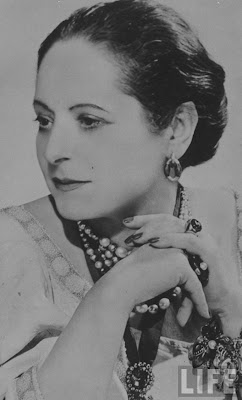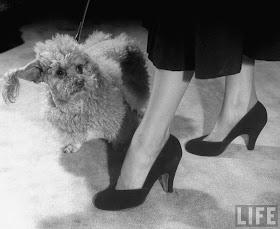The Development of Women's Makeup from the 1920's to the late 1940's
See Also:
Vintage Make-up Guides - rare downloadables
The History of Lipstick
Shiseido - The Story of Japanese Beauty Makeup in the 1930's
1930's Beauty Guide
Complete 1940's Makeup Guide
The Correct way to apply 1940's Make-up
During the early years of the 20th century, make-up became fashionable in the United States of America and Europe due to the huge influence of Ballet, Theatre and the Movie stars of Hollywood.
Chief amongst the makeup wizards who helped develop cosmetics into a global mass market were Max Factor Sr, Elizabeth Arden, and Helena Rubinstein.
Post World War One , the Flapper look came into fashion and with it came cosmetics: Dark kohl eyes,Red lipstick, Red nail polish and it was fashionable for women to use bleach to keep their skin a pale milky white - in otherwords a good palette for cosmetics !
Of course Coco Chanel helped make the suntan popular and heralded the introduction of fake tan products helping both men and women to achieve that sun-kissed look !
In Asia, skin whitening continued to represent the ideal of beauty.
Max Factor

Truelly the inventor of Glamour !
He invented the term "makeup," based on the verb, "to make up" (one's face).
To millions of women all over the world today, the name Max Factor goes hand in hand with beauty,fashion and above all glamour!
I started collating a timeline of makeup and glamour only to realise that it almost goes hand in hand [ with just a few exceptions] with the inventions of Max Factor Snr.
In 1914 he created the first cosmetic made specifically for motion pictures!
It was a form of thin greasepaint.
In 1920 he developed the "Color Harmony" principles of makeup, which held that "certain combinations of a woman's complexion, hair and eye coloring were most effectively complemented by specific makeup shades."

This principle established for the first time that certain combinations of a woman's complexion, hair and eye coloring were most effectively complemented by specific makeup shades prescribed in "Color Harmony"
He created lip gloss in 1930.

Carole Lombard,Joan Blondell, Jean Harlow, Claudette Colbert and Bette Davis amongst others became regular visitors to his Hollywood Boulevard beauty salon. With stars like these as clients Max Factor's name began to appear in the movie credits.

In 1934 he introduced Liquid Nail Enamel, forerunner of today's nail enamels.

In 1935 he created Pan-Cake, the forerunner of modern cake makeup originally developed for color films.
The name is derived from "pan" because of its small, flat, pan-like container, and "cake" because of the form in which it was made!


Pan Cake later developed into the Pan Stick.
Though today women still puff away with loose powder and liquid foundations, the all in one panstick is present in every makeup bag to this day.
Max Factor's name appeared on many movie credits, and Factor himself appeared in some cameos.
He created many appearances for these actresses, such as Clara Bow's heart-shaped/pierrot lips.
Years later, he exaggerated Joan Crawford's naturally full lips to distinguish her from the many would-be stars copying the Clara Bow look he created.
A few final amusing notes on Max Factors genius .
He was always researching the science of beauty.
Below is the infamous Max factor Beauty Micrometer !

Max Factors Facial Ice Pack
He developed a special bonnet for the benefit of actresses who wished to refresh their faces on hot studio sets without spoiling their makeup, the facial ice pack [ pictured below ] was quickly diverted to another purpose by festive Hollywoodians. The headpiece, adorned with water-filled plastic cubes, is kept in the refrigerator while the water freezes.

Those girls really suffered for the art of glamour !
Photo courtesy of Modernmechanix
Elisebeth Arden
She invented the concept of the "makeover" in her salons.
Arden collaborated with A. Fabian Swanson, a chemist, to create a "fluffy" face cream. The success of the cream, Venetian Cream Amoretta, and corresponding lotion, Arden Skin Tonic, led to a long-lasting business relationship. This revolutionized cosmetics, bringing a scientific approach to formulations.

Other innovations included creating foundations that matched a person's skin tone; creating the idea of the "Total Look" in which lip, cheek, and fingernail colors matched or coordinated; and the first to make a cosmetics commercial shown in movie houses.
During World War II, Arden recognized the changing needs of the American woman entering the work force. She showed women how to apply makeup and dress appropriately for careers outside the home.
Arden also introduced modern eye makeup to North America after her formal training in Paris in 1912.
Helena Rubinstein
"There are no ugly women, only lazy ones."
Rubinstein formed one of the world’s first cosmetic companies and is recognised chiefly for her ability in marketing ! She was especially popular in the glam days of the 1950's.


A vicious rivalry with the other great lady of the cosmetics industry Elizabeth Arden also marked her life. Both Rubinstein and Arden, who died within 18 months of each other, were social climbers.
And they were both keenly aware of effective marketing and luxurious packaging, the attraction of beauticians in neat uniforms, the value of celebrity endorsements, the perceived value of overpricing and the promotion of the pseudo-science of skincare.
The Powder and the Glory (2009) by Ann Carol Grossman and Arnie Reisman, details the rivalry between Rubenstein and Elizabeth Arden.
So that's the three big names in the development of makeup in the golden age of glamour.
I think you'll agree that Max Factor was the real genius.
I'll leave you with some images depicting the makeup looks of the 1920's,1930's,and 1940's
The 1920's Makeup Look


The 1930's Makeup Look

The 1940's Makeup Look


Vintage Make-up Guides.com
Visit our definitive Vintage Make-up Guide Site, packed with beautiful downloadable 1920's makeup guides, 1930s make-up guides, 1940s make-up guides and 1950s make-up guides.
Also Glamourdaze highly recommends Gabriela Hernandez's book Classic Beauty - The history of Make-up
Copyright - Glamourdaze 2010






























